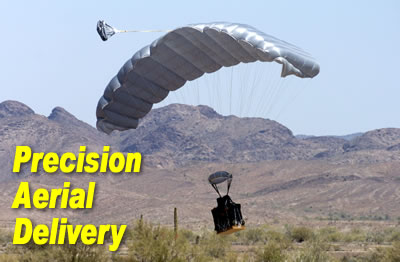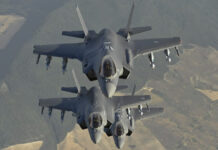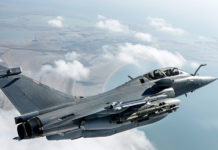Start < Page 1 of 6 >
Aerial delivery by parachute has been practiced extensively, but until the introduction of the ram-air parachute this capability has not changed dramatically since the WW2 era. In recent years air drops were implemented in most conflicts, for example, over Sarajevo, Bosnia-Herzegovina, Kosovo, Afghanistan and, most recently – over South Lebanon, air drops were performed from low altitude, despite enemy threat by missiles and anti-aircraft guns.
 Current airdrop procedures are complex systems that, in most cases are tied to known high risk choke points, such as aerial and sea ports of debarkation and pre-planned drop zones. Drop zones are sometimes marked with colored-smoke grenades or large canvas markers. That, followed by the low-flying planes, could give away the drop zone’s location.
Current airdrop procedures are complex systems that, in most cases are tied to known high risk choke points, such as aerial and sea ports of debarkation and pre-planned drop zones. Drop zones are sometimes marked with colored-smoke grenades or large canvas markers. That, followed by the low-flying planes, could give away the drop zone’s location.
In the military context, air-delivery, usually synonym to speedy service is bogged down into a series of complex preparations outpaced by the operational tempo of modern battle. Moreover, the higher an aircraft drops its load, the less accurate the landings become. Therefore, to enable accurate delivery, low-altitude drops are performed, but naturally, with higher risk involved. Low level drops, classified as anything under 2,000 feet (600 m’) altitude, these procedures expose the plane and its crew to the risk of enemy anti-aircraft guns and MANPADS.
Since drop zones are planned, prepared and marked in advance by so-called “pathfinder teams” planning the air drop, enemy observation can, in time assemble rapid-reaction forces to try and jeopardize the mission. While pallets are scattered over a large area, ground units arriving at the drop zone to collect the deliveries could be exposed to enemy ambushes. This was practiced with deadly effect by Vietcong during the Vietnam war. Sometimes air delivered cargo is lost in ‘no man’s zone’ or much worse, in enemy territory, requiring rescheduling more air sorties for replacement supplies to be delivered, an expensive loss in time and funding. For example, in Afghanistan, where air delivery is used extensively to re-supply forces in remote locations, drop zones are severely restricted by terrain and weather conditions, dispersing loads up to 1,000 meters from designated points, forcing the troops on the ground to hike and hunt for the urgent supplies.
Read additional parts of this article:
- Precision Aerial Delivery
- Profiling the Wind
- GPS Guided Cargo Systems
- JPADS XL Program
- JPADS – The Way Ahead
- ULAV – Unmanned logistics air vehicles




















